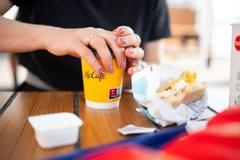Top Packaging Trends 2023: “Plastics circularization” leads sustainability charge amid greenwashing backlash

22 Feb 2023 --- Innova Market Insights has revealed its top packaging trends for 2023, with “Plastics circularization” taking the lead spot. Plastic packaging consumption will continue to grow despite anti-plastic sentiment and increasingly stringent waste management regulations. Forward-thinking brands see a future for plastic packaging that can support the circular economy.
“Green but clean,” “Renewable rebellion,” “Meaningful connections” and “Reusable revival” complete the global market researcher’s top packaging trends. Greenwashing fears will abound amid a surge in on-pack environmental claims, creating opportunities for brands that can defend sustainability messaging with validated science.
Meanwhile, paper-based and bioplastic packaging, connective technologies and reusable packaging systems will continue to gain traction on the journey toward greater environmental sustainability.
Trend one: Plastics circularization
Plastic isn’t going anywhere. Although plastic reduction initiatives are gathering pace and renewable alternatives are on the rise, plastic’s inherent qualities as a lightweight, versatile and hygienic material means that production and consumption continue to increase.
Now, the main focus for governments and the industry should be on delivering recycle-by-design packaging and recycling systems that can help reestablish plastic within a circular economy.
Innova Market Insights found that 61% of global consumers believe the increased use of plastic packaging is necessary – although perhaps undesirable – since the COVID-19 pandemic for safety reasons.
Despite the plastic pollution crisis and poor recycling rates, 72% of global consumers still believe plastic has average or above recyclability relative to other materials. Moreover, half (52%) say they would pay more for a product if it came in recyclable packaging.
 Consumer behavior is seen by many as a leading cause of plastic pollution (All infographic credits: Innova Market Insights).“In an effort to improve plastic circularity, we’re noticing an increasing shift toward monomaterial films using LDPE and PP, for which recycling infrastructure already exists,” says Akhil Eashwar Aiyar, projects leader at Innova Market Insights.
Consumer behavior is seen by many as a leading cause of plastic pollution (All infographic credits: Innova Market Insights).“In an effort to improve plastic circularity, we’re noticing an increasing shift toward monomaterial films using LDPE and PP, for which recycling infrastructure already exists,” says Akhil Eashwar Aiyar, projects leader at Innova Market Insights.
The use of flexible LDPE packaging for F&B products has grown 8.6% on average between 2018-2022, driven by demand from the ready meals and meat, fish and poultry categories.
Leading the charge, ProAmpac has launched high-performance retort pouches containing post-consumer recycled material for human and pet food applications and a monomaterial film for microwave vegetable steaming.
For more complex, multilayered packaging, investment in chemical waste recycling is rising. Rabobank predicted that advanced recycling plants will double to around 140 plants globally by 2025.
On the regulatory front, more stringent legislation like plastic packaging taxes, mandatory recycling goals and EPR and DRS schemes are incentivizing the circular economy transition, although recycled plastic remains expensive worldwide.
Trend two: Green but clean
Consumers want sustainability, but they don’t want to be misled. Innova Market Insights flagged that environmental claims like “carbon impact,” “reduced packaging” and “plastic-free” on F&B packaging have almost doubled (92%) since 2018. However, the proliferation of sustainability messaging has created fears of unsubstantiated claims.
“In order to appease the eco-conscious consumer, we have observed a surge in product offerings over the past few years that capitalize on the consumer sentiment with ‘green’ claims that may not necessarily be substantiated,” says Aiyar.
“For products that do feature verifiable claims regarding end-of-life cycle, we continue to grapple with consumer uncertainty regarding the proper disposal of such packages to facilitate effective waste management.”
Environmentalists said they expected a “lawsuit tidal wave” after the UN announced plans to establish a global plastic pollution treaty, while regulators are clamping down on false advertising as demands on big businesses to clean up their plastic waste grows.
Recently, McDonald’s, Nestlé and Danone were put on notice for failing to abide by France’s “Duty of Vigilance” laws on plastic reduction targets. Anti-plastic sentiment has cooled amid pandemic-related hygiene demands.
Anti-plastic sentiment has cooled amid pandemic-related hygiene demands.
Meanwhile, the European Commission found that more than half (53%) of the product claims it assessed in 2020 gave “vague, misleading or unfounded information about products’ environmental characteristics.”
In the UK, the Competition and Markets Authority is investigating how products claiming to be “eco-friendly” are being marketed and whether consumers are being misled.
But the greenwashing wave also empowers honest brands capable of delivering scientifically-validated claims supported by transparent and regulated mechanisms like plastic credits, with some suggesting we have entered a “post-LCA world.”
Global consumers increasingly demand product transparency around sustainability claims, with 47% wanting to see the level of a pack’s environmental impact illustrated as a score or grade, and 34% saying that a reduced carbon footprint score positively influences their purchasing decision.
Trend three: Renewable rebellion
Not everyone is keen on petrochemical plastics. Pollution and climate change fears and geopolitical uncertainties around the availability of oil and gas – exacerbated by the war in Ukraine – are driving the movement to renewable packaging made from paper and bioplastics.
“Fluctuations in the prices of oil and gas, which act as substrates for manufacturing polymers, is likely to provide an impetus for companies to further explore bioplastics and packaging solutions made from renewable sources such as paper,” says Aiyar.
“Policymakers in certain countries have already set initiatives in place, bifurcating their waste streams to prepare for the eventual influx of bioplastic solutions and prevent the adulteration of existing polymer recycling streams.”
According to Innova Market Insights, F&B product launches that feature either a biodegradable or compostable claim have almost tripled since 2018, with categories such as tea, coffee and confectionery accounting for nearly half of these launches.
The renewable packaging trend looks set to continue amid growing consumer support. Only 7% of global consumers perceive paper-based packaging as unsustainable, while only 6% see bioplastics as unsustainable.
Innovation in renewable packaging is also hitting new heights, with Amcor, Mondi and Coveris among a list of suppliers pushing the shelf life and functionality boundaries of paper-based packaging.
Meanwhile, European Bioplastics expects global bioplastics production to almost triple by 2027. In 2022, packaging remained the biggest market segment for bioplastics (48% by weight).  The vast majority of consumers scan connective packaging for extra production information at least some of the time.
The vast majority of consumers scan connective packaging for extra production information at least some of the time.
Trend four: Meaningful connections
Consumers exist in a connected world and packaging is increasingly seen as a valuable platform for digital engagement. Technologies like QR codes, NFC and AR have begun to emerge in recent years as cost-effectiveness and consumer appetite grow.
Innova Market Insights revealed that 77% of global consumers are now interested in engaging with connected packaging technologies on-pack via their smartphones.
While these technologies have mainly been implemented to boost consumer-brand engagement with loyalty reward programs and big data collection for targeted marketing, they are increasingly being employed as tools to support circularity and inclusivity.
“When exploring interactive packaging, we notice a shift toward leveraging such technologies to provide greater product transparency and facilitating farm-to-fork traceability, but also for enabling greater accessibility and inclusivity and expediting sorting at waste management facilities, instead of focusing heavily on consumer-driven brand engagement,” explains Aiyar.
In notable examples, Evian and Reward4Waste created a digital DRS to support water bottle recycling at the Wimbledon tennis championships. Similarly, Giunko unveiled a digital environmental labeling system, which provides disposal information through a product’s barcode and is accessible to blind and visually impaired people.
In other inclusivity strides, Coca-Cola Europacific Partners printed smartphone-scannable NaviLens codes on cardboard multipacks to help partially sighted shoppers access product information.
Trend five: Reusable revival
The best way to combat waste is to avoid creating it. This is the stance of major regulatory bodies like the European Commission, which envisages reusable and refillable packaging solutions as pivotal to its Green Deal circularity targets.
Although reusable and refillable systems have been slow to take off in the F&B space amid scalability challenges, consumer belief in the long-term sustainability of such models remains strong and brands will continue to explore the viability of wider-scale rollouts this year. Recyclable and reusable packaging are most commonly viewed as sustainable by consumers.
Recyclable and reusable packaging are most commonly viewed as sustainable by consumers.
Innova Market Insights highlights that reusability is seen as an important packaging-related purchasing influence by 43% of global consumers – the most widely highlighted aspect and on par with hygiene (42%) and shelf life (42%).
Meanwhile, the most common reasons for consumers not adopting reusable packaging systems are lack of availability and hygiene, with 29% of global consumers pinpointing these concerns.
“Despite the initial fervor, very few initiatives to drive the adoption of reusable packaging systems within retail FMCG have withstood the test of time. Yet locally driven, country-specific initiatives focusing primarily on navigating the shift toward a reusable packaging ecosystem within the foodservice industry continue to gain momentum,” says Aiyar.
“Also, personal care and household products have had a higher adoption of refill or reusable packaging solutions, with companies capitalizing on leveraging this trend as an avenue to achieve plastics savings. This relative success could be attributed to lower consumer concerns regarding the safety of reusable packaging for non-food applications.”
Recently, Unilever’s Dove Canada launched a refillable case made from stainless steel for its range of deodorants.
Meanwhile, returnable and resealable mailers are rising to prominence amid the ongoing expansion of e-commerce, which was spurred by the COVID-19 pandemic. For example, Mondi has created paper-based mailers for fashion e-retailers, which boast easy resealing functionality for return shipments.
By Joshua Poole
Innova Market Insights’ consumer survey was conducted in Brazil, Canada, China, France, Germany, India, Indonesia, Spain, Mexico, the UK and the US.











